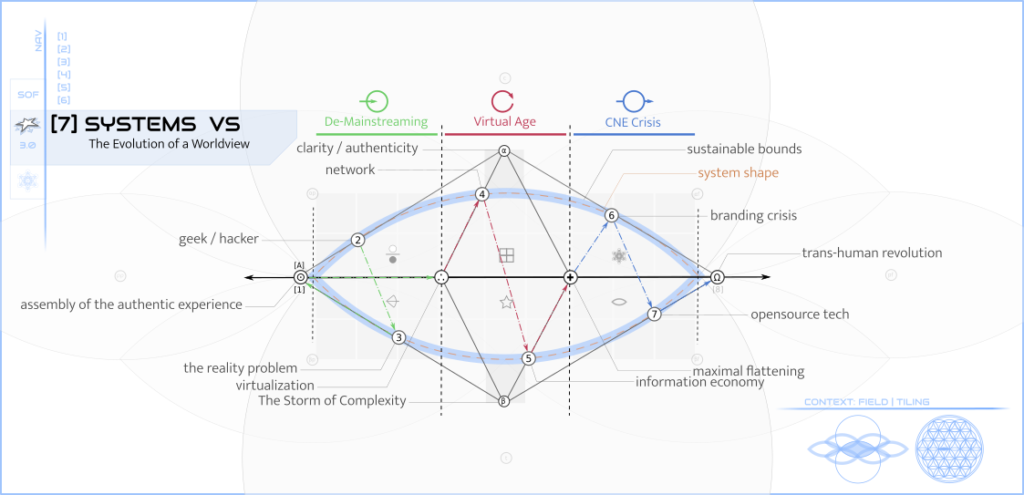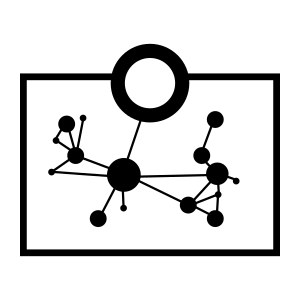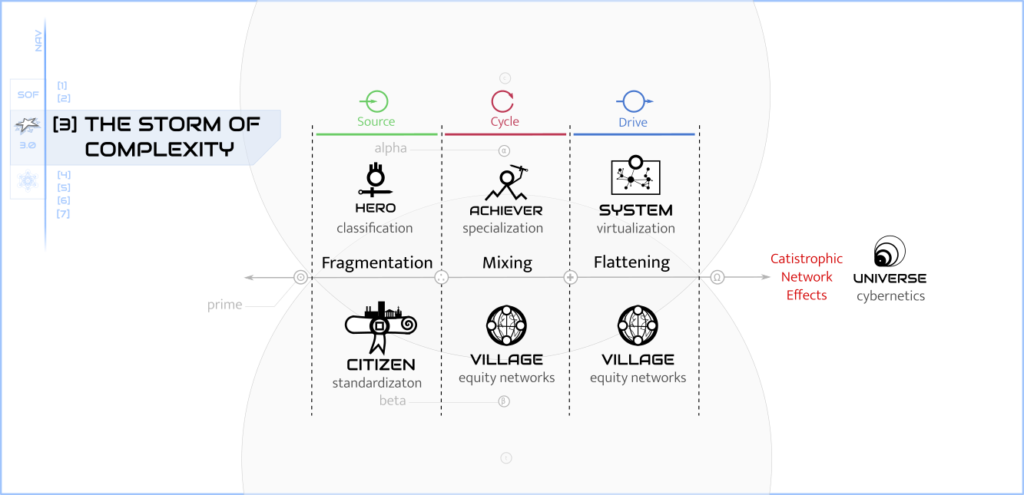
Systems VS
The Systems Value System (VS) is the seventh value system type in the Emergent Value Systems (EVS) Spectrum. This is the native worldview of the Internet or Dot-Com generation. Systems VS reached mainstream status as Gen X came of age in the Nineties, and has been the most prevalent value system of both Gen X and Gen Y as they reached adulthood. The system entered its Stability phase after the Y2K Scare in the first decade of the Twentieth century. It has since reached its zenith with the ubiquity of social networks and mobile technologies. As the IoT (Internet of Things) takes hold and the Triple Crisis (COVID-19 / E2020 / BLM-#MeToo) showed people the looming issue of Catastrophic Network Effects (CNE), the system has reached its Decline phase as the Universe VS rises.

The Systems Value System
- Systems VS Evolution
- Elements of System VS
- Assembly of the Authentic Experience | Meta-narrative ([1], ⊙)
- Clarity in a World of Complexity | Project (α)
- The Storm of Complexity | Environmental Challenge (β)
- Geek / Hacker | Identity Complex (2)
- The Reality Problem | Existential Crisis (3)
- Virtualization | Systemic Innovation (∴)
- Network | Social Organization (4)
- Information | Economy (5)
- Maximal Flattening | Empowerment Paradox (✛)
- Branding Crisis | Legacy (6)
- Opensource Tech | Toolboxing (7)
- Trans-human Revolution | Exit Revolution (Ω, [8])
Systems VS Evolution
De-Mainstreaming | Early / Crisis Phase
The success of the consumer and actualization economies, especially in late Twentieth century America and Europe, created a new synthetic material and psycho-social world. Marketers kept the demand-engine of the market economy running by continually offering new manufactured experiences to the people: “Now, own this.” “Now, eat this.” “Now, wear this.” “Now, be this.”
The cornucopia of material, social, and media experiences offered for consumption reached its zenith in the cable and satelite television networks of the Nineties. There was a dissolving of universal experiences that had once been central to modernity. You could be into anything and find it on a channel if only you subscribed to enough of them. This led to the rise of the geek – the person knowledgeable in a niche. It also led to an un-mooring of the definitions of reality and identity as the condition of Luminoid Permanence — constant change and disorientation leading to fluid identity — became the norm. No longer could people agree on what was cool or even what was real.
The nineties were the first decade to do without aesthetic distinctions between mainstream and marginal popular cultures; since then, the clash between establishment and avant-garde has become as obsolete as duelling.
— Frank Guan “Chuck Klosterman Brings Back the Nineties” (Book Review). The New Yorker, Jan 31 2022.
Also contributing to the De-mainstreaming was a direct Systems VS resistance to over-emphasis on quorum-community in the Village VS. Village VS Equity networks claim to fulfill the self-actualization of all people, but paradoxically, in order to achieve equity, some portion people’s self-actualization must be suppressed. Systems VS felt this imposition as a fundamental denial of humanity and so didn’t want to agree with the mainstream or join in mainstream projects, thus their “whatever” attitude to all things external. They wanted to be who they were and have the experience authentic to them, even if it represented something totally niche.
Virtual Age | Mid / Stability Phase
The Y2K scare was a testament to both how Systems VS had entered the mainstream through the automation of financial and business systems and the suspicion others systems held of the new comer’s agenda. When the disaster never materialized, it was a green light for launching the Virtual Age. Soon, social media was allowing Systems VS to virtualize vast amounts of information about their interests and collaborate in new ways both online and in real life. The mobile revolution extended this from people’s computer desks to all of life on-the-go, and the technologies of virtualization entered into all the systems of work and business ushering in the Age of Big Data. Whether people knew it or not, or wanted it or not, their every move, activity, and preference was being tracked and profiled online by machine learning and AI logarithms for the purpose of corporate and government agendas.
CNE Crisis | Late / Decline Phase
The massive, flat networks built by Systems VS created the perfect environment for an unfortunate phenomenon of massively-connected webs: Catastrophic Network Effects. Network effects are emergent phenomenon that evolve and spread across networks like a wave as node after node in a network are effected through their connections. These effects can reach catastrophic consequences when the emerging change is overly-disruptive or negative. The first phenomenons of CNE were related to blips in automated systems (2010 Flash Crash) or the domino-effect of a few bad actors (black-hat hackers, domestic copy-cat terrorism). But eventually, the worse waves of CNE where the consequences of inter-connected human nature and our tendencies towards greed, panic, cruelty, polarization, and misinformation. As networks on all levels have become increasingly global and real-time, CNE has disrupted real world systems in the global supply chain of real goods with real consequences as much as it has disturbed relational systems through social networks.
Elements of System VS
Assembly of the Authentic Experience | Meta-narrative ([1], ⊙)
The story at the core of the System VS has to do with the being authentically alive in a world fragmented by modern media, materialism, and radical individualism. While Systems VS is no less individualistic or fragmented than proceeding value systems, they adopt a strategy of assembly — connecting fragments of life together — to produce a “real to me” experience. This is reflected in two prominent System VS phenomenon: (1) Systems VS interacts economically as constant de-constructors and re-assemblers in their strategies for work and in their patterns of consumption. (2) They are conspicuous in their quest for ultimate experiences that must be witnessed by clouds of “authenticating acquaintances” (FB frends).
People say that what we’re all seeking is a meaning for life. I don’t think that’s what we’re really seeking. I think that what we’re seeking is an experience of being alive, so that our life experiences on the purely physical plane will have resonance within our innermost being and reality, so that we actually feel the rapture of being alive.
— Joseph Campbell in The Power of Myth (with Bill Moyers). Anchor, 1991. pg 5.
Clarity in a World of Complexity | Project (α)
The great project of the System VS is to provide systemic clarity in complexity. This pervades the products and services they create and what they think is cool. Google seeks to produce clarity by making all the world’s information easily locatable and rankable. Apple seeks to make all personal information and interactions smoother through absolute clarity in interface design. The list goes on and on. If the key problem faced by the system is the confusion and paralysis caused by the surrounding complexity of our lives and environments, the first solution is being able to cut through it all to find something to focus on.
The Storm of Complexity | Environmental Challenge (β)
The key Systemic Innovation of each of the value systems that have contributed to modernity (systems 3-5) and post-modernity (systems 6 & 7) has lead to a compounding exponential increase in the complexity of human life, work, and environment called The Storm of Complexity. The three fundamental factors of this storm are the tendencies towards fragmentation, mixing, and flattening embedded in human enterprise in the late Twentieth and early Twenty-first Centuries.

Geek / Hacker | Identity Complex (2)
Because of complexity, Systems VS denies the “total systems mastery” claimed by leaders and experts of the past. Instead, they only believe in niche mastery: the rise of the geeks. Emphasizing learning by direct doing with the support of other geeks connected online, geeks advocate “getting into something” as the best mode of experience. Rather than trying to know everything about a system too complex to comprehend, the geek finds out enough to hack the system and get it to produce the results she wants. If the result requires interacting with large section of a complex system, geeks will form a collaboration with other geeks to combine their niche knowledge into a shared script library or tool to get results.
Related:
- The Hacker Ethic
- Geek / Hacker genres: Life Hacks, Brain Hacks, Bio Hacks, Memes, Maker/DIY, Opensource
The identity of “geek” also gives reference to Systems VS growing up in Liminoid Permanence – fluid identity because of constant, disorienting change. As De-mainstreaming led to the disintegration and fragmentation of any central narrative for society, emerging Systems VS thinkers have struggled to find traditional markers of identity and normalcy. This led to experiences of coming-of-age that were permanently disorienting so that Gen-X did not achieve the usual sense of “normality” in adulthood. Rather, they felt permanently “weird” and marginal and developed the “whatever” reaction to all structures and interactions because of this fundamental disassociation.
An example of this comes from Everclear’s song “Father of Mine” describing the effects of a dissolving family, common during Systems VS emergence:
I will never be safe
— Art Alexakis, Craig Montoya, Greg Eklund. Everclear “Father of Mine” | So Much for the Afterglow
I will never be sane
I will always be weird inside
I will always be lame
The Reality Problem | Existential Crisis (3)
As the founders of the Systems VS grew up in the Achiever VS and Village VS world a key problem emerged for them: determining what was real so reality could be grasped and responded to. The extreme materialism brought by the Achiever VS consumer-industrial complex led life to feel synthetic and manufactured. The “Nanny-state” and actualization economy which Village VS set up to provide and enforce equity and maintain equity networks led people to feel discontented from fundamental components of the human experience and the high-contrast experiences of life interacting with the natural world.
One of the first System VS experiments dealing with The Reality Problem was the Grunge Movement. It went to extremes to “be real” with greasy unwashed hair, natural-fiber textiles, and acoustic instruments in “alternative rock” (meaning alternative to Pop). Ironically, the movement still spread among the youth through MTV and VH1 — mass media networks owned by mega-corporations conspiring to sell to the new generation.
What is real? How do you define ‘real’? If you’re talking about what you can feel, what you can smell, what you can taste and see, then ‘real’ is simply electrical signals interpreted by your brain.
— Morpheus, The Matrix (Lana Wachowski, The Matrix: The Shooting Script)
Additional Examples:
- The modern American grocery store: every food you can imagine to eat, but none of it just real food (except that one isle).
Virtualization | Systemic Innovation (∴)
The Dot-Com Boom gave the System VS the chance to move from an aesthetic movement in Grunge to a power player. Through the power of the Internet, geeks bypass the former guardians of reality and construct it for themselves. But in order to construct reality online – that is in a digital medium – everything must be virtualized. Virtualization is the Systemic Innovation of the System VS underlying all the system has achieved — the ability to create shareable representations of real-world phenomenon and their relationships to each other to exponentially increase human symbolic representations of reality and, at the same time, open up new levels of mass collaboration.
If you’re going to vituralize everything, but your meta-narrative is producing an authentic experience, you’ll need a way to clarify and authenticate everything you virtualize. The System VS solution to this is that the network authenticates whats real together. Every entity that is virtualized is a node in the network, whether the node is an individual human, machine, group, community, or massive globo-corp. All human-visible nodes become a brand (the smallest version of which is an icon). Evocative brands that create a “real” feeling when encountered are the best. The the network tags the branded node to authenticate it by ascribing their feelings, judgments, and connections to the node.
This shows up in the following familiar systems:
- Tagging and commenting on social media
- Ratings and review systems on online marketplaces
- Memes that “tag” common experiences using clips of popular media
- AI-assembled and curated marketing profiles for all users of online services
- Product packaging that increasingly must include evocative branding and the tagging of the contained experience
Network | Social Organization (4)
Of course, the social organization of the Systems VS is the network, but all social organization could be thought of as a network of relationships, so that is not unique among value systems. What is unique is the often low-leader or leaderless nature of the System VS network. According to Systems VS, power should either be flat, or, if it cannot be flat, it should be available to the fully authenticated. The best form of authentication, according the the value system, is some form of thresholding: as nodes output more benefits to the network or are connected to more by other nodes — really as the provide more useful de-complexifying clarity — they are then authenticated by a certain quantifiable threshold of organic trust within the network.
Examples:
- Google search result rankings
- Standard defining in opensource dev communities and developer networks.
- Post and reply thresholds to unlock abilities on stackoverflow.
- Sell and buyer trust ratings on markets like eBay.
- Verified purchase ranks on market ratings.
- Traffic reporting and routing in Gmaps mobile apps.
Information | Economy (5)
The term information economy is slightly convoluted. While information is definitely treated like a commodity to be bought and sold (this is not different from all value systems where knowledge is a marketable item), it is not the primary commodity in the information economy. It is the information economy because there is now a complete virtualization for every economic item, including customers, and a digitization of production, distribution, marketing, and consumption of each and all products.
Proof of Concept:
Colonial Pipeline ransomeware attack: in May 2021 fuel prices on the East Coast of the US quickly rose (and nudged up prices elsewhere) due to a hacking attack that locked down the digital systems controlling the largest gas delivery piplines in the US. Nothing was wrong with the gas or the hardware. But the computers which saw all these components as information were
Maximal Flattening | Empowerment Paradox (✛)
The opensource nature of Systems VS networks has further flattened the world built by Village VS and disrupted by The Storm of Complexity. This flatness is a double-edged innovation. While the flattening has opened up access and empowered many users in the networks with new awareness and capacities, it has also removed almost all natural barriers that protect people’s lives from the intrusion of other users and CNE.
Examples:
- People have begin to turn on the mega-corps that were the early heroes of the Virtual Age for a variety of issues: privacy and data security, user-empowerment, wokeness, employee/consumer experience, and climate change to name a few. As a response, many corporate leaders are jettisoning Maximize Shareholder Value (MSV) Capitalism in favor of a resurgence of Stakeholder Capitalism — albeit one that must include the accountability visible to social networks.
Branding Crisis | Legacy (6)
Nodes in the networks, be they people or other entities, are identified by brands. Brands strive to win trust by providing clarity through authenticity – where the meta-narrative and the project meet. However, as the maximal flattening of the empowerment paradox leads to Catastrophic Network Effects, no brand is immune to connections that erode its image and overall trust within the network. Some of the CNE are due to conflict between actors within networks and some of the CNE are run-away dynamics related to how Systems VS has increase the intensity of the Storm of Complexity for most people rather than diminished it. In either case, people feel brands — if the were “real”, had true clarity, or authentic power — should be able to control the CNE. This leads to never-ending cycles of brand-disillusionment and rebranding — from global mega-corporations to individual influencers on Youtube — often through the extremely expensive task of pruning and re-authenticating the brand’s network.
Examples:
- The “Cancel Culture” crisis of both personal brands and corporations across mainstream and social media, especially following the social and political polarization around the 2020 election.
- Facebook’s self-censureship and re-branding as “Meta” (a transition to a Universe VS concept) as it was being blamed for not controlling misinformation in the triple cataclysm of COVID-19 Pandemic, The BLM/#MeToo Civil Rights Awakenings, and The 2020 Election.
Opensource Tech | Toolboxing (7)
Portions of the System VS have already reached the toolboxing phase for individuals and groups who are transitioning to the new system. Most notable among the “tools” in this toolbox is the geek mass-collaboration strategy built around the virtualization of work called “opensource”. In opensource, a code base and set of standards are established and shared freely with a broad network of collaborators who build solutions together. The results are free for any collaborator or user to deploy where needed and are supported using networks of developers and users.
This revolution in workflow as been the foundation of all the major IP behind the largest and most successful companies of this system. Opensource is also behind the medical and scientific collaborations that are disrupting the field of biotechnology. It is the foundation of crowdfunding, the influencer economy, and the sharing economy as well. Opensource as the driver and key innovation achieved through virtualization will carry on as a “cloud of tools” into future systems. Indeed, opensource technologies and strategies lie at the center of all major advancements that are enabling the media, communities, and technologies of the trans-human revolution and Universe VS.
Trans-human Revolution | Exit Revolution (Ω, [8])
Many users have grown unsatisfied with Systems VS world due to corporate intrusion, and/or their exposure to mass human nature and CNE. For them, assembly of a verifiable authentic experience has become confused or failed. While virtualization is useful, the network itself cannot be trusted. They see the problem as more fundamental. Instead of assembling just experiences, they seek to assemble their authentic self from the network and all it offers. They are more than just a node: they will weave themselves from the universal fabric, a twist in the never-ending field of human experience and enterprise and the aspire to the recognition of all they are. These are the trans-humans, those who find themselves always moving between categories into intesectionalities that tie together universal threads.

